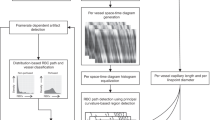Summary
Our own development of fluorometric scanning techniques in intravital microscopy of the microcirculation is described. Very tiny amount of fluorometric substances are detected with a high temporal and locational resolution. The everted small intestinal mesentery of the rat serves as a model. We have given a detailed description of the microscopes used, the optical systems, the conditions of measurement of the microfluorometry, the scanning techniques and the evaluation of the measurement data. The present state of technical development detects 10−12 g of a fluorochromed plasma protein in 8 ms in a measurement field of 2 µm2. The four-digit measurement data of a scanning line of 200 µm length in 0.25 µm locational resolution are registered in about 2 s.
Similar content being viewed by others
References
Baker CH, Nastuk WL (1986) Microcirculatory technology. Academic Press, Orlando London
Bloch EH (1963) A method for studying the dynamics of transcapillary transfer quantitatively at the microscopic level in situ in living organs. Angiology 14:97–106
Curry FE, Joyner WL, He P (1987) Modulation of transcapillary exchange in individually perfused microvessels. In: Tsuchiya M et al. (eds) Microcirculation — an update, vol 1. Elsevier, Amsterdam, pp 105–108
Friedman JJ, Witte S (1986) The radial protein concentration profile in the interstitial space of the rat ileal mesentery. Microvasc Res 31:277–287
Gahm T (1983) Quantitative bildanalytische Untersuchung der Wanddurchlässigkeit von Blutkapillargefäßen mit Hilfe der Fluoreszenzmikroskopie. Diplom-Arbeit, Universität Stuttgart
Gahm T, Reinhardt ER, Witte S (1984) Analysis of the wall permeability of blood vessels in the rat mesentery. Res Exp Med 184:1–15
Gahm T, Witte S (1986) Measurement of the optical thickness of transparent tissue layers. J Microsc 141:101–110
Gerlowski LE, Jain RK (1985) Effect of hyperthermia on microvascular permeability to macromolecules in normal and tumor tissues. Int J Microcirc Clin Exp 4:363–372
Kaley G, Altura BM (1977) Microcirculation, vol. 1. University Park Press, Baltimore London Tokyo
Ley K, Arfors K-E (1986) Segmental differences of microvascular permeability for FITC-dextrans measured in the hamster cheek pouch. Microvasc Res 31:84–99
Meesen H (1977) Microcirculation. Hb Allg Pathol, Bd 3/7. Springer, Berlin Heidelberg New York
Nairn RC (1976) Fluorescent protein tracing, 4th edn. Churchill Livingstone, Edinburgh London New York
Nakamura Y, Wayland H (1975) Macromolecular transport in the cat mesentery. Microvasc Res 9:1–21
Papenfuß HD, Schwarzmann P, Sträßle R, Witte S (1986) Intravital microscopy and theoretical analysis of interstitial transport of fluorescent macromolecules near vascular walls of rat mesentery. Poster: 14th Int Conf Eur Soc Microcirc, Linköping
Piller H (1977) Microscope photometry. Springer, Berlin Heidelberg New York
Taylor AE, Granger DN (1984) Exchange of macromolecules across the microcirculation. In: Renkin EM, Michel CC (eds) Handbook of physiology: Cardiovascular system, vol 4. American Physiologic Society, Baltimore, pp 467–520
Thaer AA, Sernetz M (1973) Fluorescence techniques in cell biology. Springer, Berlin Heidelberg New York
Wayland H (1982) A physicist looks at the microcirculation. Microvasc Res 23:139–170
Wiederhielm CA (1966) Transcapillary and interstitial transport phenomena in the mesentery. Fed Proc 25:1789–1798
Witte S (1957) Eine neue Methode zur Untersuchung der Capillarpermeabilität. Z Ges Exp Med 129:181–192
Witte S (1957) Fluoreszenzmikroskopische Untersuchungen über die Capillarpermeabilität. Z Ges Exp Med 129:358–367
Witte S (1963) Flow pattern pertaining to vascular permeability as observed by fluorescence vital microscopy. In: Copley AL (ed) Proc IVth Int Congr Rheol, Providence, RI, pt 4: Symposium on biorheology. Wiley and Sons, New York London Sydney, pp 451–458
Witte S (1967) Methodische Möglichkeiten zum Studium der Gefäßpermeabilität durch intravitale Fluoreszenzmikroskopie. Klin Wochenschr 45:961–965
Witte S (1975) Microscopic techniques for the in situ characterization of concentration of tissue components and penetrating molecules. Biorheology 12:173–180
Witte S (1979) Microphotometric techniques in intravital microcirculatory studies. J Microsc 116:373–384
Witte S (1980) Quantitative vitalmikroskopische Befunde über VF (vascular factor). Quad Coagul Argom Connessi 18:7–70
Witte S (1980) Concentration of macromolecules in the tissue and lymphatics. In: 28th Int Congr Physiol Sci, Budapest. Adv Physiol Sci 7:201–210
Witte S (1981) Transkapillärer Austausch von Mikro- und Makromolekülen. Arzneimittelforsch 31:2020–2028
Witte S (1983) Intra- und extravasale Verteilung von Gerinnungsproteinen. Wechselwirkung mit der Gefäßwand. Behring Inst Mitt 73:13–28
Witte S (1984) The role of blood coagulation in capillary permeability. Vital microscopic contributions. Biorheology 21:121–133
Witte S (1986) Thrombin as a permeability influencing agent. Proc 6th Bodensee Symp Microcirc, Heidelberg. Progr Appl Microcirc 12:212–216
Witte S, Hagel F, Schuler H (1971) Eine Objektkammer für die intravitale Ultraviolett-Mikrospektrophotometrie. Z Ges Exp Med 154:334–338
Witte S, Zenzes-Geprägs S (1976) The affinity of fibrinogen to the vessel wall as proved in situ. 9th Eur Conf Microcirc, Antwerp. Bibl Anat 16:279–281
Witte S, Zenzes-Geprägs S (1977) Extravascular protein measurements in vivo and in situ by ultramicrospectrophotometry. Microvasc Res 13:225–231
Witte S, Zenzes-Geprägs S (1978) Die Beeinflussung des in situ gemessenen extravasalen Proteingehaltes durch Änderung der Gefäßpermeabilität. Res Exp Med (Berl) 172:83–96
Author information
Authors and Affiliations
Additional information
Supported by the Deutsche Forschungsgemeinschaft and the Fritz Thyssen-Stiftung
Rights and permissions
About this article
Cite this article
Witte, S. Scanning microfluorometry in intravital microvascular research. Res. Exp. Med. 189, 229–239 (1989). https://doi.org/10.1007/BF01852254
Received:
Accepted:
Issue Date:
DOI: https://doi.org/10.1007/BF01852254




